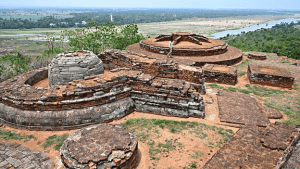TAG: GS 1: ART AND CULTURE
THE CONTEXT: Srikakulam, a district in the far northern corner of Andhra Pradesh bordering Odisha, is home to numerous significant historical and cultural sites.
EXPLANATION:
- Despite its rich heritage, the district is often overlooked, prompting a concerted effort by scholars, historians, and enthusiasts to restore its prominence.
Historical Significance of Srikakulam
- Formerly part of the Kalinga region, Srikakulam’s history dates back to the 4th century BC during the rule of the Nanda dynasty.
- The region declared independence after Chandragupta Maurya overthrew the Nandas in 322 BC.
- Excavations have uncovered pre-Mauryan era artifacts such as black polished pottery and punch-marked coins, indicating long-term Nanda rule.
- The Kalinga War in 261 BC, led by Chandragupta’s grandson Ashoka, resulted in Kalinga being incorporated into the Mauryan Empire.
- The aftermath of the war saw Ashoka embrace Buddhism, laying a strong foundation for the religion in the region.
Buddhist Heritage
- Srikakulam is renowned for its Buddhist sites, including the Salihundam site near Gara and the Dantapuri site near Amadalavalasa.
- Salihundam, located on the banks of the Vamsadhara River, has well-preserved remnants of Buddhist structures such as stupas and apsidal brick chaityas.
- The site was discovered in 1919 by writer Gidugu Rama Murthy and contains sculptures of Buddhist deities Mareechi and Tara.
- These structures date from the 2nd century BC to the 12th century AD and indicate the spread of Buddhism from this region to Sumatra and other far-eastern countries.

The Salihundam Buddhist site located in Gara mandal of Srikakulam
Preservation Efforts
- The Archaeological Survey of India and the Tourism Department have undertaken initiatives to preserve the Salihundam site.
- However, the Buddhist structures in Dantapuri have suffered damage.
- Local historians and heritage enthusiasts continue to advocate for the promotion and preservation of these sites.
- The Indian National Trust of Art and Cultural Heritage (INTACH) has urged the government to focus on the promotion of Buddhist and Jain sites, including those near Tangamayyakonda and Rottavalasa villages.
Neolithic Caves and Ancient Temples
- In addition to its Buddhist heritage, Srikakulam is home to Neolithic-era caves, such as those discovered at Nandi Hills in Vennalavalasa village.
- These caves, measuring 190 feet long and 80 feet deep, add another layer to the district’s historical significance.
- Ancient temples in the region also highlight Srikakulam’s rich cultural past.
- The village of Singupuram, associated with Sri Lanka (formerly known as Simhala), is noted for the Hathakeshwara Swamy temple constructed by Simhabahudu.
- This temple underscores the historical connections between Srikakulam and neighboring countries.
Advocacy and Promotion
- Eminent poet, writer, and historian Deerghasi Vijayabhaskar has been a vocal advocate for the recognition of Srikakulam’s heritage.
- His book, “Veerakalingam,” emphasizes the district’s historical significance and connections to the Nanda and Maurya dynasties, as well as its links to Sri Lanka.
- Vijayabhaskar has called for detailed research into the Buddhist sites and the region’s historical association with Sri Lanka and Kalingandhra.
- Senior journalist and writer Bendalam Krishnarao has also been active in promoting Srikakulam’s heritage.
- Through his online magazine “Nitya,” he aims to raise awareness of the district’s rich history among new generations and the diaspora.

